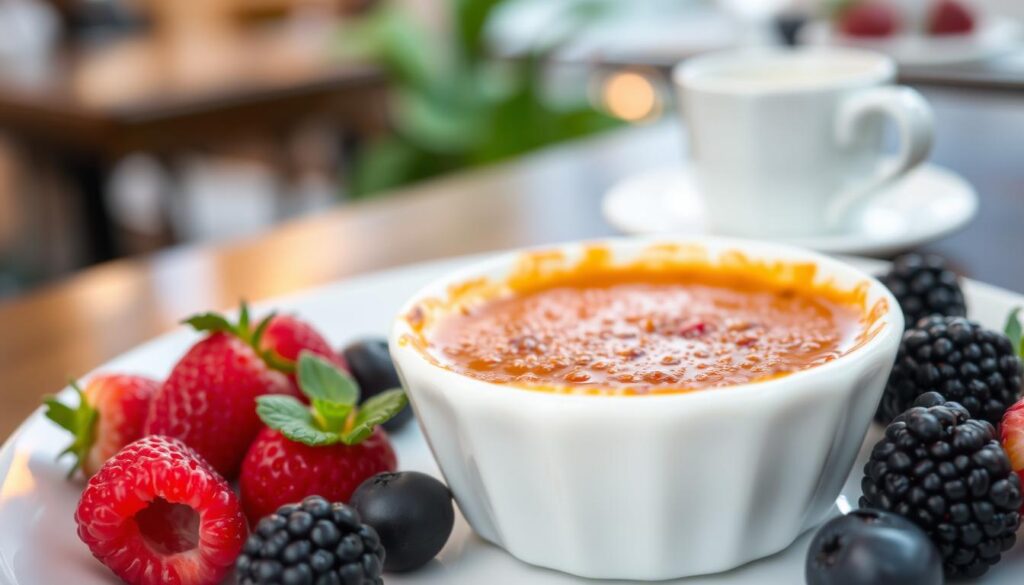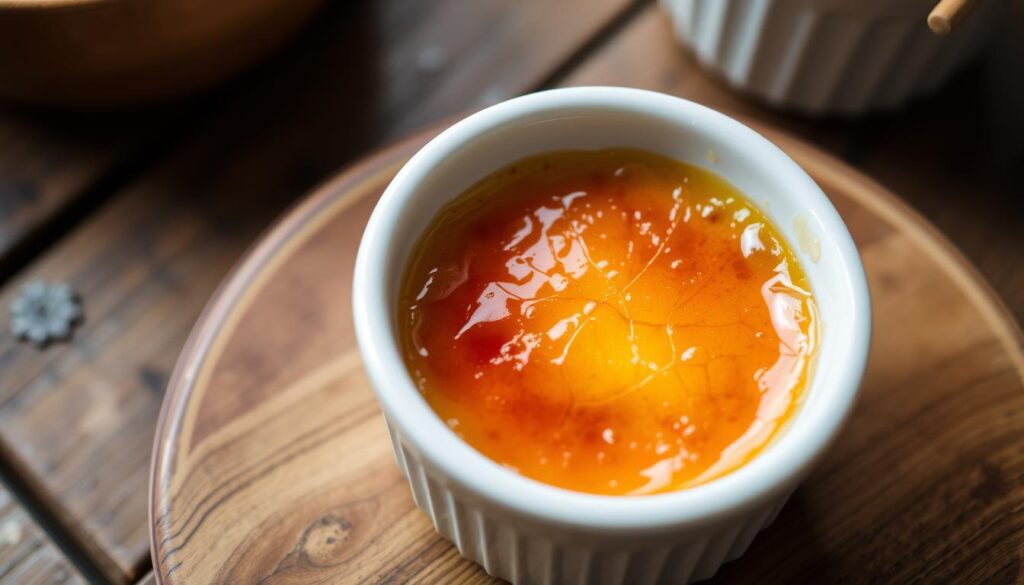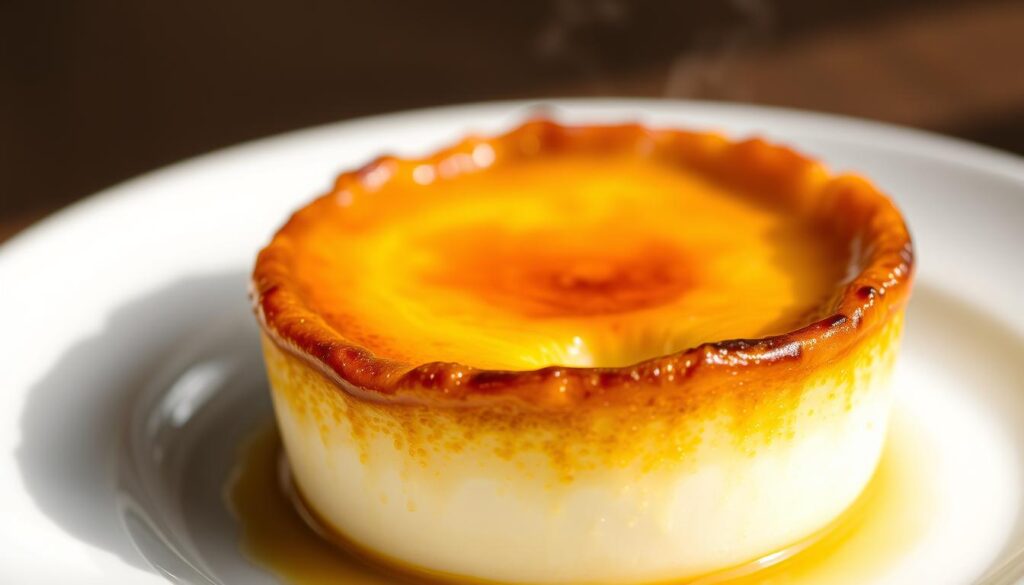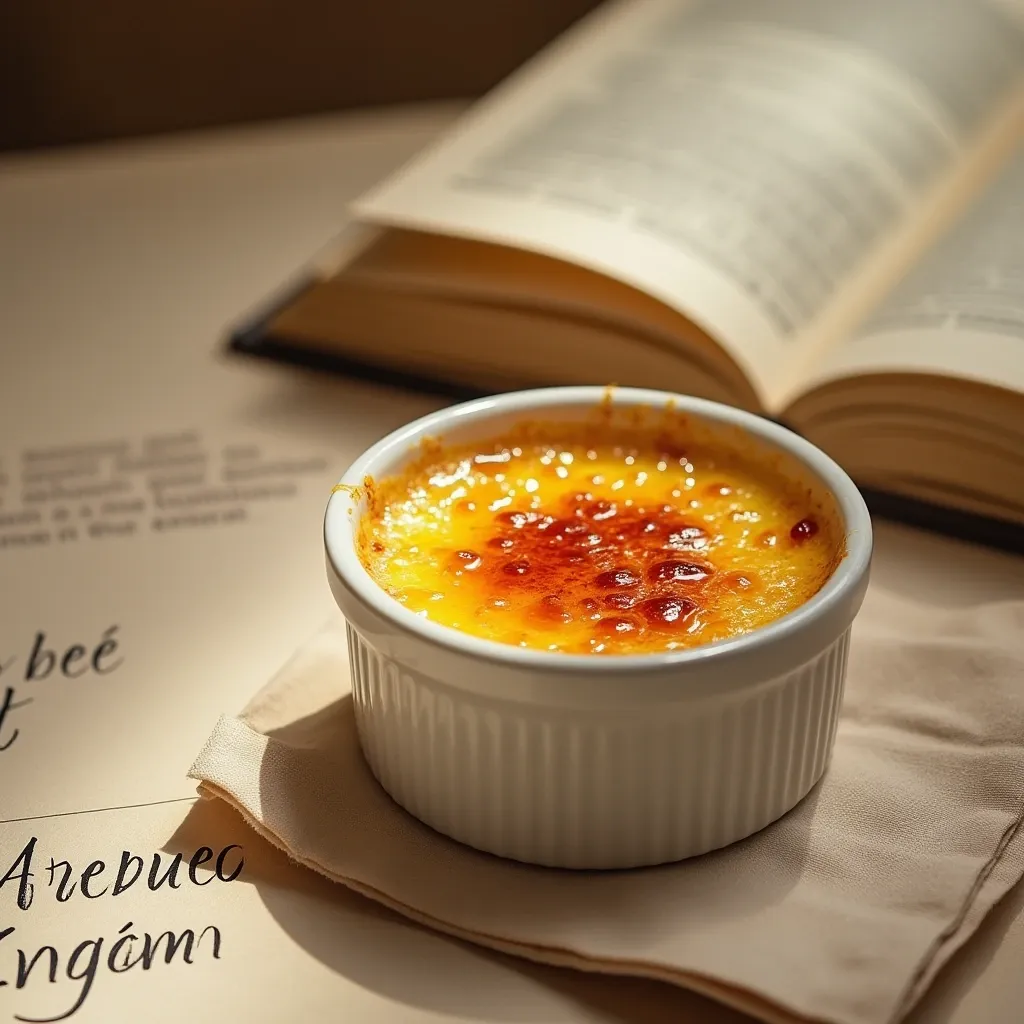Crème brûlée, also known as “burnt cream” or “Trinity cream,” is a French dessert. It has a creamy custard base topped with caramelized sugar. The debate on where it comes from involves France, England, and Spain.
The first recipe for crème brûlée was in a 1691 French cookbook. It was called “crème anglaise” back then. This name suggests it might have come from England.
In England, a similar dessert was famous at Trinity College, Cambridge. It was called “burnt cream” or “Trinity cream.” The college crest was even burnt into the sugar topping. Some think this English version might have started as early as 1630.

The debate on crème brûlée’s origins is ongoing. Spain also has a version called crema catalana, which dates back to the Middle Ages. Crema catalana is different because it includes cinnamon and citrus zest. Despite the debate, crème brûlée remains a favorite dessert worldwide.
Understanding Crème Brûlée: A Classic French Dessert
Crème brûlée is a famous French dessert known for its creamy custard and caramelized sugar. It has won the hearts of many dessert lovers around the world. Its history goes back to the 15th century in England, where a similar dessert was enjoyed.
Essential Components of Traditional Crème Brûlée
The secret to a true crème brûlée is the right mix of ingredients. It starts with a creamy custard base made from cream, vanilla flavor, egg yolks, and sugar. This custard is the base for the caramelized sugar topping.
The Signature Caramelized Top Layer
The caramelized sugar crust is what makes crème brûlée special. It’s made by sprinkling sugar on the custard and then caramelizing it with a torch or broiler. This creates a golden, glassy layer that adds a unique flavor.
Basic Ingredients and Preparation Methods
To make the perfect crème brûlée, you can use the “hot” or “cold” method. The “hot” method heats the cream, vanilla flavor, and sugar with egg yolks. The “cold” method bakes the custard in a water bath until it’s set. The dessert needs to chill and set before adding the caramelized sugar.

What is the English version of crème brûlée?
The English version of crème brûlée is called “burnt cream” or “Cambridge burnt cream.” It was first made at Trinity College, Cambridge in 1879. It was named “Trinity Cream.” The college’s coat of arms was even imprinted on the top of the cream using a branding iron, giving it a distinct visual appeal.
While the English burnt cream is similar to the French version, it has its own special ways of making it. It also holds a special place in British cuisine. The Trinity Cream, as it was originally known, has become a lasting part of Cambridge and the UK’s food history.

The history of this dessert goes back to the 17th century. There were flan-like dishes before the modern crème brûlée. But the burnt cream in England has made it a favorite in the country’s food traditions.
Historical Origins in British Cuisine
Crème brûlée is often linked to French cuisine. But, its roots go back to an English dessert called “burnt cream.” Trinity College, Cambridge, claims to have served this dessert as early as 1630. It was known as “Cambridge burnt cream” and had the college’s arms branded on top.
Trinity College’s Burnt Cream Legacy
The Trinity College version of burnt cream had a caramelized top layer. This was a key step towards the modern crème brûlée. It set the stage for the dessert’s growth in British cooking.
Cambridge’s Contribution to the Dessert
Cambridge and burnt cream have a long history together. Cookbooks from the 18th and 19th centuries in England talk about similar desserts. This helped the dish evolve in British cuisine.
Evolution of English Cream Preparations
The term “burnt cream” was first used in 1702 in an English cookbook. This shows its importance in English cooking. Many variations of the dessert are found in old English texts. This shows the rich history of cream-based desserts in England.
French Culinary Heritage and Development
The origins of crème brûlée go back to France’s rich culinary history. It first appeared in François Massialot’s 1691 cookbook. The recipe used egg yolks, milk, and flour, with a pinch of flour.
Massialot said to sweeten the top and burn it with a hot iron to get a golden color. This shows the French influence on this classic custard dessert.
The method of browning dishes with a hot iron was known in French culinary history by 1651. But it was not used for custard desserts like crème brûlée then. This technique, with a custard base, shows French traditions that led to this iconic French cuisine staple.
Over time, crème brûlée recipes have changed, with new flavors and techniques. But the rich custard base and caramelized top are key. The lasting love for crème brûlée shows the lasting impact of French culinary heritage worldwide.
The Battle for Origin: England, France, and Spain
The origins of crème brûlée, a beloved European dessert, have sparked culinary disputes for centuries. The French claim it as their own, but the Spanish say their crema catalana came first. This debate fascinates food historians and fans alike.
Competing Historical Claims
Some believe the first custard-like dessert was described in Bartolomeo Stefani’s 1662 book, “Latte alla Spagnuola.” This has led some to think the Spanish dessert influenced the French crème brûlée. Yet, the French say their version started in the 17th century, with the first recipe in 1691’s Le Cuisinier Royale et Bourgeois cookbook.
Regional Variations and Influences
As the dessert became popular across Europe, different versions appeared. In Spain, the crema catalana is also called crema de Sant Josep and is eaten on March 19th. It’s made with milk and cornstarch, unlike the French version, which is richer with milk, cream, and sometimes flour. These differences add to the debate about where it came from.
Classic Recipe and Traditional Preparation Methods
The classic crème brûlée recipe is all about balance. It starts with a rich custard base. This is made from cream, sugar, egg yolks, and vanilla.
The custard is baked in ramekins in a water bath. This method ensures it cooks evenly and stays creamy.
After cooling, the magic begins. A layer of sugar is sprinkled on top. Then, a caramelization technique turns it into a golden, caramelized crust.
Traditionally, French chefs use a salamander for this step. But, you can also use a butane torch at home. This gives the dessert its signature look.
The end result is a dessert that pleases the senses. It has creamy custard and a crunchy caramel top. It shows the beauty of French cooking.
The Art of Caramelization Techniques
Making the perfect crème brûlée is an art that has grown over time. The secret to its caramelized top layer is caramelization. Traditionally, people used a kitchen torch or even a fire shovel to get the caramelized crust. Now, most use a kitchen torch for better control and consistency.
Achieving the Perfect Crack
The secret to a perfect caramel layer is even sugar distribution and controlled heat. Some chefs prepare caramel discs separately and place them on the custard before serving. This ensures a consistent sugar caramelization that shatters with a perfect crack when tapped.
Whether using old or new methods, the aim is to get that satisfying crunch. This crunch gives way to the rich, creamy custard beneath. With practice and the right technique, anyone can master caramelizing the caramel layer for a remarkable crème brûlée experience.
Modern Interpretations and Flavor Variations
The classic crème brûlée has seen a big change, thanks to chefs who love to try new things. They’ve added many flavor infusions to this favorite dessert. This shows how culinary innovations from chefs worldwide are making desserts better.
Now, you can find crème brûlée with chocolate, fruit, liqueurs, and even savory flavors. Chefs are trying new custard bases and caramelizing methods. These changes make gourmet desserts even more special. They keep people coming back for more, whether it’s in fancy restaurants or cozy cafes.
Crème brûlée has become more than just a dessert. It’s a treat that keeps evolving, exciting dessert lovers everywhere. From the traditional vanilla to unique flavors like chocolate-chili or raspberry-rose, there’s always something new to try.
The Rise to Global Popularity
Crème brûlée became very popular in the 1980s, mainly in the United States. A famous scene in “The Fabulous Destiny of Amélie Poulain” helped make it more popular. Sirio Maccioni’s Le Cirque restaurant in New York City also played a big role in making it famous.
American Restaurant Renaissance
In the 1950s and 1960s, crème brûlée was everywhere in American magazines and cookbooks. But it really took off when it was added to Le Cirque’s menu in New York City. This made it a hit across the country, starting a big craze.
The 1980s saw a new version of crème brûlée at Le Cirque, inspired by Spanish Crema catalana. This version helped keep the dessert’s popularity high in the U.S.
International Appeal and Adaptations
Crème brûlée has become a favorite around the world. Countries like Spain, Brazil, France, and Japan have their own versions. This shows how diverse baked custard can be in different cultures.
In the U.S., crème brûlée has inspired many new desserts. You can find crab brulee, ice cream, donuts, cupcakes, and cakes. This makes it clear that crème brûlée is a beloved dessert globally.

